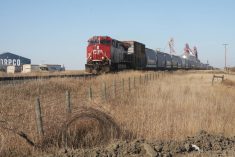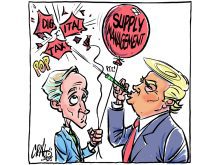Lucky chicken
Re: July 24 pet story contest, Lucky the chicken.
Grace Gwyer’s story about her pet chicken Lucky was thoroughly charming. I appreciated her sharing some insight into Lucky’s personality and intelligence.
Ms. Gwyer implied that we humans tend to see chickens as dumb, yet Lucky demonstrated how very misunderstood these animals are.
Although Lucky met with an unfortunate end, at least she was able to experience what life should be like for a hen. She had the freedom to stretch her wings, explore, nest, scratch and peck for food and even go to sleep according to her own biological clock.
Read Also

Agriculture needs to prepare for government spending cuts
As government makes necessary cuts to spending, what can be reduced or restructured in the budgets for agriculture?
It’s unfortunate that hundreds of millions of chickens found on Canada’s industrialized farms never get this opportunity.
Lucky’s story is a wonderful reminder that all animals deserve our compassion and the freedom to engage in their natural behaviors, even if they are being raised for food.
By purchasing animal products that are farmed in more humane environments, such as certified organic, free-range eggs, we would make a difference in the lives of a few more “lucky” birds.
– Leanne McConnachie,
Director,
Farm Animal Programs
Vancouver Humane Society,
Vancouver, B.C.
Whose standards?
The nerve! My Conservative MP Gerry Ritz just mailed out a fake survey with the bold caption, “Nobody is above the law.”
Is he kidding? His band … has absolutely no moral authority to condemn anyone for doing what they do themselves. They have shown over and over that they don’t believe that the normal rules of justice, democracy or even the law apply to them.
They clearly broke the law when they removed barley from the jurisdiction of the Canadian Wheat Board by executive order, and were so indignant to be held to the same standard of law as we ordinary folk that they appealed the court ruling. They lost the appeal, of course. …
Ritz himself is so contemptuous of the law that he asked for a specific list of names of CWB permit book holders an unbelievable third time after clearly being told the first two times that it would be a breach of the privacy act to provide such a list. The Tories want to put more people in jail? They can start with themselves….
– Glenn Tait,
Meota, Sask.
Pipeline for farmers
The Alberta government has committed $4 billion for a pipeline system to collect and bury pollution generated by private corporations. So why couldn’t they do the same for farmers? Why couldn’t they commit $4 billion for a pipeline for farmers?
Why do farmers need a pipeline? A pipeline for what? A pipeline to where?
Farmers need a pipeline to reduce their transportation costs. Farmers need a pipeline to transport their farm products … to world markets.
No, this is not some “pie-in-the-sky” idea; the technology exists today. While there is no system like this operating, it is equally true for the system the Alberta government is proposing. Both exist in theory only.
The least expensive mode of transport is thousands of years old – pipeline. Coal has been moved by pipeline for decades. Companies are planning to move tar sands from Alberta by pipeline for processing in the United States.
To get one’s mind wrapped around this concept, one has to envision what can be rather than what is. Envision moving wheat by pipeline at 10,000 km-h from the Midwest to the coast for a few dollars per ton. Compare that with what it costs today by rail. …
Solid goods can be moved in a container pipeline using maglev transport technology. Check the web for tube transport (and) maglev technology.
Since the fuel used is electricity, the net use is small because decelerating unit trains travelling within the pipeline generate electricity back into the system, similar to a system employed in some cars today.
The unit trains travelling within the pipeline travel in a vacuum so there is very little air resistance. Automatic airlocks reduce vacuum loss. Automatic loading and unloading systems handle high volumes of goods. Small pipeline systems feed into a major pipeline.
Where should the main pipeline go? A study is needed to determine this. …
The transport routes to be studied might include one from Manitoba east and west; Manitoba south into the United States, Saskatchewan east and west, Saskatchewan south into the United States….
This is not a new idea. Maglev technology was available in the 1970s. China operates a maglev train moving people at high speed. The technology has been proven but the political will and leadership is lacking. Time for farmers to push for a pipeline.
– Bill Thompson,
Pincher Creek, Alta.
Price available
Re: Comment by John De Pape, Turn off CWB propaganda, WP, July 31.
Mr. De Pape should really base his statements on what he knows because he obviously knows very little about wheat marketing in western Canada.
Through Canadian Wheat Board daily price contracts, fixed price contracts, basis price contracts and future price contracts, we all have the same opportunity as our neighbours to the south to price.
Plus, here in Western Canada, we also have the option of delivering our wheat and voluntarily pooling the price for the year. Or, if we think next year’s price will be higher, we can even deliver it in one year and have it go into the next year’s pool.
This past year that meant that anyone who did this will receive approximately an additional $160 per tonne for last year’s wheat. We also have the option to buy or sell paper if we want.
We could CWB fix price wheat at $6 and then buy a Minneapolis call option to replace that sale.
Here in Western Canada, farmers are eligible for $100,000 interest free loan on our commodities to help pay expenses until the crop is delivered. Western Canadian farmers also had the option to sell wheat for $20 a bushel or better right at their local elevator.
Anyone of us could have locked in a CWB March basis for No. 1 CWRS, 13.5 percent protein on Feb. 26, 20007, for 86 cents over (and) then on Feb. 26, 2008, lock in the CWB future’s price of $811.46, which would have given you a final price of $812.32 per tonne in store Vancouver.
At our farm here in Alberta we would have received $767.32 per tonne or $20.88 per bu. in the bin.
Mr. Ritz, we have a group of individuals working on a better system of marketing wheat and barley. Why don’t you let them do their job while you concentrate on the real issues facing agriculture today in Western Canada?
– Dwayne Marshman,
Rockyford, Alta.
Effective tools
Despite John De Pape’s spin (Opinion, July 31,) Western Canadian farmers will receive over $7 billion from grain marketed through the Canadian Wheat Board in 2007-08.
This includes $560 million in additional revenue for wheat and durum that can be attributed directly to the CWB’s pooled approach to selling.
The extra $560 million was calculated by comparing the spring wheat and durum pool returns with the U.S. weighted average farmer monthly receipts, published by the United States Department of Agriculture.
Despite Mr. De Pape’s assertions, the CWB has never said it had a crystal ball to predict grain prices in the future. However, a disciplined pooled approach to marketing is an effective risk management tool that, during the extremely volatile 2007-08 crop year, resulted in significant benefits for producers.
The average U.S. producer sold their wheat early at $6 to $7 per bushel – prices that looked attractive at the time. Saskatchewan farmers are seeing pooled returns at the farmgate of about $8.50 per bu. for spring wheat and $12.30 per bu. for durum.
Recognizing, however, that one size does not fit all, the CWB’s board of directors has led the development of a slate of Producer Payment Options for farmers who want more choice in pricing and delivery.
Last year, 14,400 producers, a record number, signed up 3.4 million tonnes under CWB Fixed Price Contracts.
– Larry Hill,
Chair, CWB Board of Directors,
Swift Current, Sask.
At mercy
There has to be intense lobbying by big players in the grain trade for Prime Minister (Stephen) Harper and (agriculture minister Gerry) Ritz wanting to desperately by all means to destroy the Canadian Wheat Board monopoly for wheat and barley to please a small group of farmers when supposedly only 10 percent of the barley is going for malting (and) feed barley is on the open market.
I think those farmers are only a front too. What is actually going on behind the scene? When we let the Crow Rate go, we were told we will pay more, but the railway will give us super service . Well we are paying more but the grain transportation is not any better, if not worse. According to the news in the paper, an average price is the best price. This is what we get from the wheat board. How many got burned by trying to guess the open market.
I think if we lose the wheat board we will be at the mercy of the grain giants and be sorry, like we are at losing the Crow Rate.
– Remi Gregoire,
Winnipeg, Man.
















